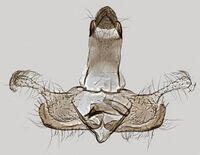Biology:Coleophora pyrrhulipennella
| Coleophora pyrrhulipennella | |
|---|---|

| |
| Coleophora pyrrhulipennella North Wales | |
| Scientific classification | |
| Domain: | Eukaryota |
| Kingdom: | Animalia |
| Phylum: | Arthropoda |
| Class: | Insecta |
| Order: | Lepidoptera |
| Family: | Coleophoridae |
| Genus: | Coleophora |
| Species: | C. pyrrhulipennella
|
| Binomial name | |
| Coleophora pyrrhulipennella Zeller, 1839[1]
| |
Coleophora pyrrhulipennella is a moth of the family Coleophoridae found in Europe. It was first described by Philipp Christoph Zeller in 1839.
Description
The wingspan is 11–14 mm. Coleophora species have narrow blunt to pointed forewings and a weakly defined tornus. The hindwings are narrow-elongate and very long-fringed. The upper surfaces have neither a discal spot nor transverse lines. Each abdomen segment of the abdomen has paired patches of tiny spines which show through the scales. The resting position is horizontal with the front end raised and the cilia give the hind tip a frayed and upturned look if the wings are rolled around the body. C. pyrrhulipennella characteristics include head light bronzy-grey, whitish-mixed. Antennae white, ringed with fuscous, basal joint with light ochreous-greyish tuft. Forewings brownish-ochreous, lighter dorsally ; a costal streak, one in disc from middle, one along fold, and one along dorsum shining white. Hindwings grey.[2] Only reliably identified by dissection and microscopic examination of the genitalia.
Adults are on wing in June and July.[3]
The larvae feed on heather (Calluna vulgaris), tree heath (Erica arborea), bell heather (Erica cinerea), Erica manipuliflora and crossed-leaf heath (Erica tetralix). They create a shining black, bivalved sheath case of about 9 mm long with a mouth angle of about 20°.[4] Full-grown larvae can be found in mid May. The pupa is formed in the larval case, which is attached to the tip of a shoot.
Distribution
The moth is found from Fennoscandia to the Mediterranean and from Ireland and Portugal to Romania and Crete.
References
- ↑ "Coleophora pyrrhulipennella Zeller, 1839". https://fauna-eu.org/cdm_dataportal/taxon/3996bf8c-01b3-460f-a665-3004c0c513e6.
- ↑ Meyrick, E., 1895 A Handbook of British Lepidoptera MacMillan, London pdf
 This article incorporates text from this source, which is in the public domain. Keys and description
This article incorporates text from this source, which is in the public domain. Keys and description
- ↑ Kimber, Ian. "37.055 BF541 Coleophora pyrrhulipennella Zeller, 1839". https://ukmoths.org.uk/species/coleophora-pyrrhulipennella/.
- ↑ "bladmineerders.nl". http://www.bladmineerders.nl/minersf/lepidopteramin/coleophora/pyrrhulipennella/pyrrhulipennella.htm.
External links
Wikidata ☰ Q5144215 entry
 |




